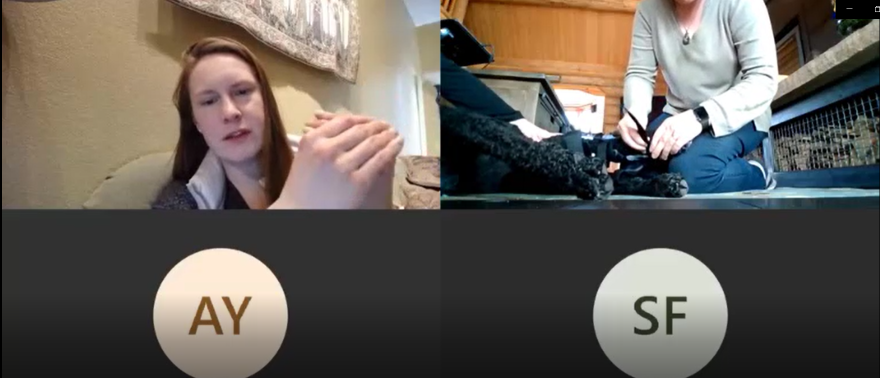Kaitlin Sisk grew up in the town of Erie, Colorado on what she calls a four-acre "family hobby farm." Her mom is a fiber artist, so they had lots of pets including angora rabbits and cashmere goats, and Sisk had her own horse.
Growing up with furry friends helped Sisk focus in on a career path.
"I think it just sort of like fell in my lap," she said. "It just seemed easy to me being around animals and working with them."
The 31-year-old is in her final year of pursuing a Doctor of Veterinary Medicine degree at Colorado State University in Fort Collins. She's studying small animals. In mid-March the veterinary teaching hospital moved all of its classes online.
"That's easy to do for some of those didactic lectures, you know, maybe not as good," said Felix Duerr, a professor who works at the hospital. "If you have a class of a hundred thirty something in front of you, you know, you can do that online as well."
The veterinary medicine program also put medical cases online and created other tools that will be useful to students even after the pandemic ends. This includes conducting daily rounds, where students meet as a group to discuss cases, virtually.
"We would just sit in front of a computer and be like, 'hey, can you point at where you see the abnormality that we're concerned about,''' said Duerr. "Now we just do that online and everybody can do it at the same time."
But the hands-on part of the program is more difficult to duplicate digitally. Take a dog that has lameness, said Duerr. A student can't feel if the knee is warmer or has instability on a computer.
"So that's probably our biggest challenge I would say," he said.
Not only have classes moved online, but the hospital staff is now using telemedicine to treat animals with non-emergency illnesses.
Theresa Wendland is a third-year sports medicine and rehabilitation resident. She uses video to to examine animals and consult with their owners. One of her patients is Oliver, a six-year-old poodle with a torn Achilles tendon.

"I've never done a distance fitting before so I'm going to apologize a little bit here that it might be a little trial and error," Wendland said during the video chat.
Before the statewide stay-at-home order, Oliver was diagnosed in person and a custom brace was ordered for him. But once the hospital closed to non-emergency patients, the brace was shipped to the dog's owner. On the video, Wendland shows her and a friend how to put it on Oliver.
"Move your hand up and give the pad a little squeeze. So that you're squeezing the pad onto his foot. There you go," she said. "Then you're pulling that strap snugly across his foot."
Wendland was a CSU veterinary medicine student and remembers the importance of hands-on clinical rotations. She worries current students are going to miss out on valuable experiences.
"So, we're trying to find ways to teach while also still providing services and help to owners and their pets," Wendland said.
Fourth-year student Kaitlin Sisk is still learning a lot online. She's on a two-week orthopedic rotation and watched Oliver get his brace then walk to make sure the fit was right.
"We still could do like a lot of what they were going to do. It's just it's harder when you can't put your hands on it," said Sisk. "But I think it's still working."
Sisk agrees that it's hard to get clinical hands-on training online. Students watch consults and surgeries remotely and study interactive videos. But Sisk has found a way to get practical experience.
"I think I'm lucky because I have a cat and a dog so I can kind of like go through the video and pause it and palpate my dog and and then keep going," she said. "I think it is like a little bit more active learning, like you have to be motivated to do it."

Overall, remote learning hasn't been too bad for Sisk. Since she can't spend her days in the hospital, she's going outside and exercising more.
Sisk is an extrovert. She worried about being stuck at home and not interacting with the people in her program. But something unexpected happened — she feels a lot closer to them now.
"I know that it's kind of weird because you'd think that you wouldn't feel close to them when you're sitting in opposite houses. But like you see their house, you see their animals come up behind them and come say hi," she said. "So, it feels like you get to see a little piece of them and their family, which I think it's something we don't really get at school. We're all business."
Sisk is graduating in May. Then she's planning to move and start a job at an animal hospital in Boulder. But when it comes to mapping out the next couple months, Sisk said, "we'll see what happens."







